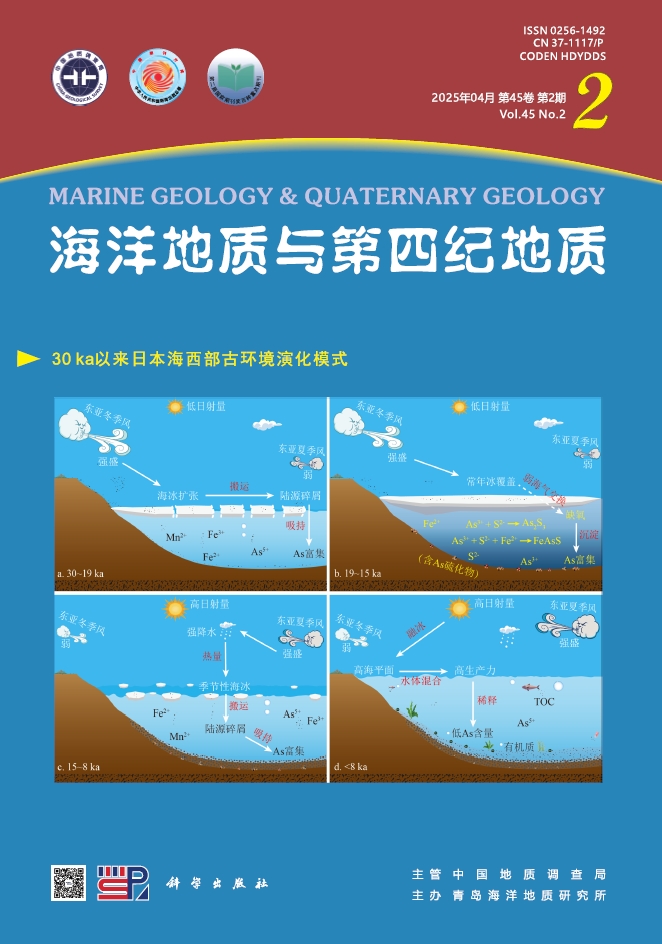| [1] |
崔琰琳,吴德星,兰健.日本海环流研究综述[J].海洋科学进展,2006,24(4):577-592.
Google Scholar
[CUI Yanlin,WU Dexing,LAN Jian.Review of study on circulation in the Japan Sea[J].Advances in Marine Science,2006,24(4):577-592.]
Google Scholar
|
| [2] |
Hsueh Y,Lie H J,Ichikawa H.On the branching of the Kuroshio west of Kyushu[J].Journal of Geophysical Research,1996,101(C2):3851-3857.
Google Scholar
|
| [3] |
Liu J P,Xu K H,Li A C,et al.Flux and fate of Yangtze River sediment delivered to the East China Sea[J].Geomorphology,2007,85:208-224.[4 Park S C,Yoo D G,Lee K W,et al.Accumulation of recent muds associated with coastal circulations,southeastern Korea Sea (Korea Strait)[J].Continental Shelf Research,1999,19:589-608.
Google Scholar
|
| [4] |
Bahk J J,Han S J,Khim B K.Variations of terrigenous sediment supply to the southern slope of the Ulleung Basin,East/Japan Sea since the Last Glacial Maximum[J].Geoscience Journal,2004,8:381-390.
Google Scholar
|
| [5] |
Yang S Y,Jung H S,Lim D I,et al.A review on the provenance discrimination of sediments in the Yellow Sea[J].Earth-Science Reviews,2003,63:93-120.
Google Scholar
|
| [6] |
Lim D I,Jung H S,Choi J Y,et al.Geochemical compositions of river and shelf sediments in the Yellow Sea:Grain-size normalization and sediment provenance[J].Continental Shelf Research,2006,26:15-24.
Google Scholar
|
| [7] |
Cha H J,Choi M S,Lee C B,et al.Geochemistry of surface sediments in the southwestern East/Japan Sea[J].Journal of Asian Earth Sciences,2007,29:685-697.
Google Scholar
|
| [8] |
Xu Z K,Lim D I,Choi J Y,et al.Rare earth elements in bottom sediments of major rivers around the Yellow Sea:implications for sediment provenance[J].Geo-Marine Letters,2009,29:291-300.
Google Scholar
|
| [9] |
徐兆凯,崔镇勇,林东日,等.日本海西南陆坡全新世对马暖流演化的沉积学和地球化学记录[J].海洋地质与第四纪地质,2010,30(1):55-64.
Google Scholar
[XU Zhaokai,CHOI Jinyong,LIM Dhongil,et al.Evolution of the Tsushima Warm Current during the Holocene:Sedimentological and geochemical records on the southwestern slope of East/Japan Sea[J].Marine Geology and Quaternary Geology,2010,30(1):55-64.]
Google Scholar
|
| [10] |
刘焱光,石学法,吕海龙.日本海、鄂霍次克海和白令海的古海洋学研究进展[J].海洋科学进展,2004,22(4):519-530.
Google Scholar
[LIU Yanguang,SHI Xuefa,L Hailong.Advances in paleoceanographic studies on the Japan Sea,Okhotsk Sea and Bering Sea[J].Advances in Marine Science,2004,22(4):519-530.]
Google Scholar
|
| [11] |
Khim B K,Park Y H,Bahk J J,et al.Spatial and temporal variation of geochemical properties and paleoceanographic implications in the South Korea Plateau (East Sea) during the late Quaternary[J].Quaternary International,2008,176-177:4661.
Google Scholar
|
| [12] |
Li T G,Sun R T,Zhang D Y,et al.Evolution and variation of the Tsushima warm current during the late Quaternary:Evidence from planktonic foraminifera,oxygen and carbon isotopes[J].Science in China Series D:Earth Sciences,2007,50(5):725-735.
Google Scholar
|
| [13] |
Lie H J,Cho C H.Recent advances in understanding the circulation and hydrography of the East China Sea[J].Fisheries Oceanography,2002,11:318-328.
Google Scholar
|
| [14] |
Gaillardet J,Dupre'B,Alle`gre C J.Geochemistry of large river suspended sediments:silicate weathering or recycling tracer[J]Geochimica et Cosmochimica Acta,1999,63:4037-4051.
Google Scholar
|
| [15] |
Choi M S,Cho Y G.Element geochemistry of suspended sediments in the Korean rivers:the Han,the Geum,the Mangyeong,the Yeongsan,the Seomjin and the Nakdong River[C]//Proceedings of the 5th International Symposium of Marine Sciences of the Yellow Sea (ISMY-V).Incheon,Korea,2001.
Google Scholar
|
| [16] |
杨守业,李从先.长江与黄河沉积物REE地球化学及示踪作用[J].地球化学,1999,28(4):374-380.
Google Scholar
[YANG Shouye,LI Congxian.REE geochemistry and tracing application in the Yangtze River and the Yellow River sediments[J].Geochimica,1999,28(4):374-380.]
Google Scholar
|
| [17] |
Lee J I,Lee Y I.Geochemistry and provenance of Lower Cretaceous Sindong and Hayang mudrocks,Gyeongsang Basin,Southeastern Korea[J].Geosciences Journal,2003,7(2):107-122.
Google Scholar
|
| [18] |
李双林,李绍全,孟祥君.东海陆架晚第四纪沉积物化学成分及物源示踪[J].海洋地质与第四纪地质,2002,22(4):21-28.
Google Scholar
[LI Shunlin,LI Shaoquan,MENG Xianglin.Chemical composition and source tracing of late Quaternary sediments in the East China Sea shelf[J].Marine Geology and Quaternary Geology,2002,22(4):21-28.]
Google Scholar
|
| [19] |
Shinjo R,Kato Y.Geochemical constraints on the origin of bimodal magmatism at the Okinawa Trough,an incipient backarc basin.Lithos,2000,54:118-137.
Google Scholar
|
| [20] |
刘娜,孟宪伟.冲绳海槽中段表层沉积物中稀土元素组成及其物源指示意义[J].海洋地质与第四纪地质,2004,24(4):37-43.
Google Scholar
[LU Na,MENG Xianwei.Characteristics of rare earth elements in surface sediments from the middle Okinawa Trough:implications for provenance of mixed sediments[J].Marine Geology and Quaternary Geology,2004,24(4):37-43.]
Google Scholar
|
| [21] |
杨守业,Jung H S,李从先,等.黄河、长江和韩国Keum、Yeongsan江沉积物常量元素地球化学特征[J].地球化学,2004,33(1):99-105.
Google Scholar
[YANG Shouye,JUNG Hoisoo,Li Congxian,el a1.Major element geochemistry of sediments from Chinese and Korean rivers[J].Geoehimica,2004,33(1):99-105.]
Google Scholar
|
| [22] |
杨守业,李从先,Jung H S,等.中韩河流沉积物微量元素地球化学研究[J].海洋地质与第四纪地质,2003,23(2):19-24.
Google Scholar
[YANG Shouye,LI Congxian,JUNG Hoisoo,el al.Geochemistry of trace elements in Chinese and Korean river sediments[J].Marine Geology&Quaternary Geology,2003,23(2):19-24.]
Google Scholar
|
| [23] |
Liu J P,Milliman J D,Gao S,et al.Holocene development of the Yellow River's subaqueous delta,North Yellow Sea[J].Marine Geology,2004,209:45-67.
Google Scholar
|
| [24] |
Li C X,Chen Q Q,Zhang J Q,et al.Stratigraphy and paleoenvironmental changes in the Yangtze Delta during the Late Quaternary[J].Journal of Asian Earth Sciences,2000,18:453-469.
Google Scholar
|
| [25] |
王可,郑洪波,Prins M,等.东海内陆架泥质沉积反映的古环境演化[J].海洋地质与第四纪地质,2008,28(4):1-10.
Google Scholar
[WANG Ke,ZHENG Hongbo,Prins M,et al.High-resolution paleoenvironmental record of the mud sediments of the East China Sea inner shelf[J].Marine Geology and Quaternary Geology,2008,28(4):1-10.]
Google Scholar
|
| [26] |
Gorbarenko S A,Southon J R.Detailed Japan Sea paleoceanography during the last 25 kyr:constraints from AMS dating and δ18O of planktonic foraminifera[J].Palaeogeography,Palaeoclimatology,Palaeoecology,2000,156:177-193.
Google Scholar
|
| [27] |
Domitsu H,Oda M.Linkages between surface and deep circulations in the southern Japan Sea during the last 27000 years:Evidence from planktic foraminiferal assemblages and stable isotope records[J].Marine Micropaleontology,2006,61:155-170.
Google Scholar
|
| [28] |
Fairbanks R G.A 17,000 year glacio eustatic sea level record:influence of glacial melting rates on the Younger Dryas event and deep ocean circulation[J].Nature,1989,342:637-642.
Google Scholar
|
| [29] |
李铁刚,江波,孙荣涛,等.末次冰消期以来东黄海暖流系统的演化[J].第四纪研究,2007,27(6):945-954.
Google Scholar
[LI Tiegang,JIANG Bo,SUN Rongtao,et al.Evolution pattern of warm current system of the East China Sea and the Yellow Sea since the last deglaciation[J].Quaternary Sciences,2007,27(6):945-954.]
Google Scholar
|






 DownLoad:
DownLoad: